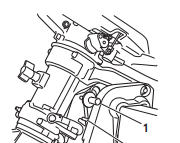Demystifying the Outboard: A simple troubleshooting guide!
You’ve had a great day out on the water sailing and are just about ready to get home. With the marina entrance in sight, you lower your outboard motor and try to start it.
…except nothing happens.
Outboard engines are fairly straightforward, but it’s not uncommon for them to have issues. To avoid finding yourself in this situation, here’s what you can do when your outboard engine won’t start…
1. Check the fuel line connection:
a. Is the fuel line attached to the engine securely?
b. Is the fuel line being pinched by the locker?
c. Is there any pressure in the bulb?
2. Check the gas tank:
a. Is the vent open? Only loosen it half a turn.
b. Does the tank have gas in it?
c. If there is an integral tank on top of the engine, is it switched to the external tank setting on the port side?
3. Check the kill switch:
a. Make sure it is attached or the engine will not start.
4. Could you have flooded the engine in your attempts to start it? If so:
a. Disconnect the fuel line.
b. Push the choke in, open the throttle all the way, and pull the chord several times
c. Wait it out for 10 minutes and attempt using the engine Restart procedure without the choke.
How do I avoid “flooding the engine”?
The outboard needs a mix of fuel and air to run. If we give excessive fuel to the engine, it will be starved of air, causing it not to start.
Most common causes of a flooded engine:
1. Attempting to start the engine more the 3 times with the Choke pulled out. The choke gives extra fuel to the engine to assist in a cold start. By attempting to start too many times with this additional fuel it will flood.
2. Bulb is pumped excessively. Again, this will send too much fuel to the engine. Don’t pump the bulb more than 2 or 3 times.
3. Using the choke when restarting the engine after sailing. You should turn the throttle to “Restart” and NOT pull the choke when the engine has already been running. Using the choke when restarting will increase your chances of flooding the engine.
Engine is Overheating (Smoking) and/or no cooling water is coming out
1. TURN THE ENGINE OFF. If the engine can’t cool itself, it can quickly cause significant damage.
2. Sail to the fuel dock or the pump-out dock.
3. If your sails are down, set your jib or do a bare poles landing on the fuel dock or the pump out dock.
4. Notify the Inspire office.
The engine tilted up and won’t go back down!
1. Leaving the engine in forward while sailing can cause it to lock in the tilted position. You can also prevent it from tilting up on its own by always pausing in neutral before shifting gears, and by storing the engine in reverse while sailing.
2. There is a small metal pin located on the engine’s starboard side (labeled “1” in section image). If the engine is tilted up, you must lift the pin towards you while also lifting the aft end of the engine. With your hand on both the pin and the back of the engine lower the engine down.
Proper Start Procedure:
1. Lower engine into the water using the middle of the three positions.
2. Attach the fuel line, checking the fuel tank for gas and open the vent half a turn.
3. Pump the bulb once or twice to push fuel through the line.
4. Check that the kill switch is attached.
5. Check that the engine is in neutral — do a slow pull of the start chord. If you feel resistance, double-check that you are in neutral.
6. Check that the throttle is turned down to Start for a cold engine and Restart if you have already had it running.
7. Pull the choke out if you are starting it for the first time. DO NOT pull it out if you are restarting the engine.
8. Pull the start chord out slowly about 8”, pull the rest off the chord out quickly to start. If it does not start in the first three pulls, put the choke in and pull again with some throttle. If it still doesn’t start, wait a little while as your engine might be flooded.
9. Slowly put the choke back in once the engine starts
10. Check propulsion by putting the engine in forward and reverse gears while safely at the dock with spring lines attached.
Proper Shut off Procedure:
1. Be sure that the throttle is all the way down and the engine is in neutral.
2. Press and hold the kill button until the engine stops.
3. Put the engine in REVERSE when sailing.
That’s it! We hope you find this information useful, and feel safe and confident using and troubleshooting an outboard motor while out on the water!



